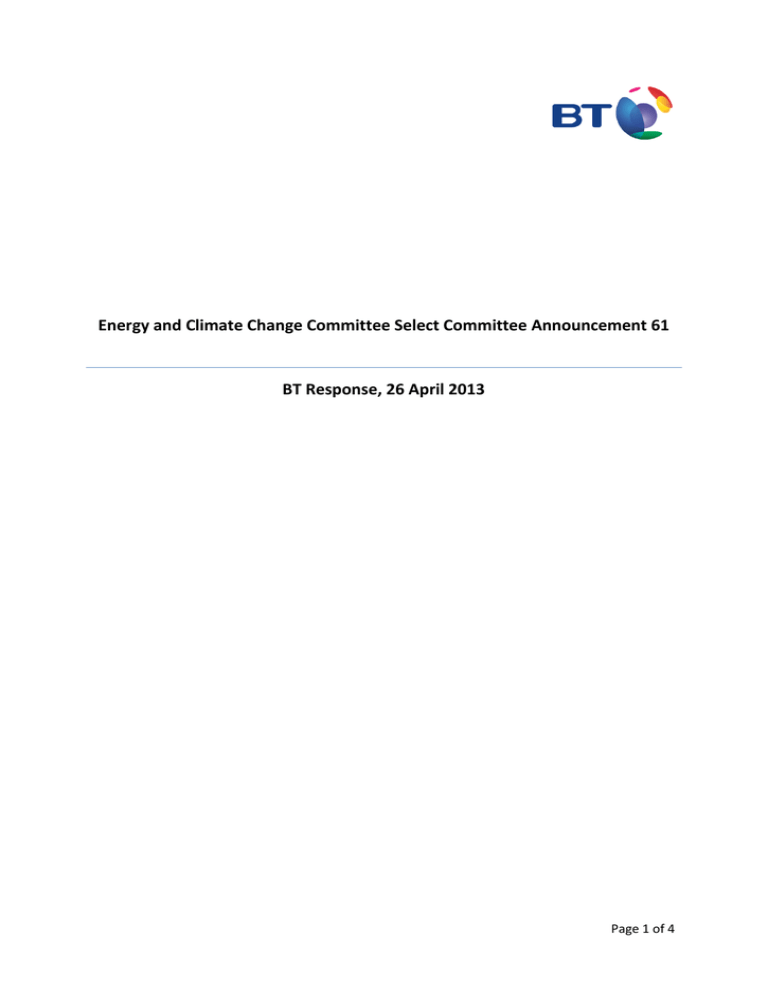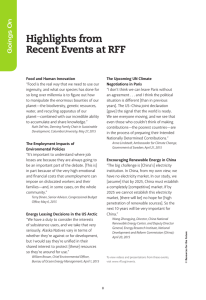Energy and Climate Change Committee Select Committee Announcement 61
advertisement

Energy and Climate Change Committee Select Committee Announcement 61 BT Response, 26 April 2013 Page 1 of 4 Introduction BT is one of the UK’s top 10 electricity consumers, using over 2TWh every year. As such, BT is extremely conscious of its total carbon impact. We have declared a target of BT reducing its UK carbon-dioxide emissions (measured in tonnes CO2 equivalent) to 80% below 1997 levels and reducing CO2e emission intensity by 80% against 1997 levels by December 2020. Although BT is working hard to reduce its energy consumption (achieving our fourth consecutive year of annual energy reduction) to achieve this goal, our aims cannot be achieved without supporting a strategy to source sustainable, low-carbon energy. BT had formerly published a target for ‘own development of 25% of wind energy on or adjacent to BT premises by 2016.’ BT remains committed to supporting the generation of new renewable energy. However, we have found the difficulty of gaining planning consent and the unpredictability of Government policy on incentives has made our own generation unfeasible. Instead, BT is now pursuing a strategy of working in partnership with others to support renewable energy generation. Specifically, we have looked to purchase renewable energy direct from wind farms using Power Purchase Agreements and signing an agreement with npower for 100% of our mainland UK grid electricity to be supplied through zero carbon electricity. What are the barriers to medium-scale energy projects in the UK? Key barriers in the planning system include: 1) the lengthy timescales involved in securing planning permission; 2) the uncertainty over the outcome of any planning application despite clear Government policy support for the generation of renewable energy; and 3) the complexity of the planning system is such that it requires expensive resource and expertise to manage applications. To allow investment in on-site renewable energy generation the Government needs to set out clearly the support that will be in place to underpin investment cases. Government had established a clear and consistent policy under the renewable obligation, which had endured for nearly a decade. There is now a myriad of policy strands and an increasing variety of tax and carbon legislation in place. The renewable energy market BT understands that a significant number of projects have been brought forward in the energy market in the 5-50MWh range, primarily by independent power producers. These projects help with the supply of low-carbon energy to mitigate climate change risks as well as providing energy security through the distribution from freely available national energy sources. However, despite the important contribution of these projects, the complicated legal processes associated with the planning system make it difficult to realise the full benefits and provides no certainty to outcome. Page 2 of 4 What different models of ownership exist for medium-sized energy projects and how prevalent are they in the UK? The majority of medium-sized energy projects are owned by private companies and limited partnerships. Currently, there is an increasing appetite for community-owned models, such as cooperative structures. BT fully supports these models as they generally deliver greater benefit to the community and enjoy a greater level of community support during the planning process. We believe there is a high level of untapped potential for community-owned medium-scale projects in the UK. Examples of this include ‘Community Energy Solutions’ and ‘Energy 4 All’. However, medium-to-large scale projects can be difficult for local communities to deliver because of barriers such as access to finance or subject matter expertise. Well-tested methods of financing small and medium sized projects include private and community equity contributions. Larger scale projects require many lenders. However, in these circumstances, power purchase agreements are critical; generators are assured of demand for their product and consumers are assured of price stability. This agreement provides lenders with a level of certainty required to invest capital in larger projects. What appetite is there among private sector organisations in the UK to invest in their own medium-scale energy projects? Private sector organisations are currently dis-incentivised from investing in their own medium-scale energy projects due to the high level of risk and uncertainty in the planning process. For example, BT obtained land rights to develop wind farms on 15 sites. However, the projects were eventually outsourced to green-field wind-farm developers as the high level of risk associated with planning applications did not fit the BT business model. It should be noted that on-site generation does not face the same barriers, but the urban nature of the majority of our sites make energy supply from such wind-farm development impractical. How effective are current Government policies in encouraging local and medium-sized energy projects? Could they be improved in any way? BT would suggest the following measures to help with investment in the generation of sustainable energy: 1) Government support could provide clearer differentiation in the support on offer for local and medium projects compared to and large scale projects 2) the complexity of the planning process should be reduced, specifically clarity should be provided around how decision are made referencing established planning policy 3) greater certainty is needed to underpin the incentives that support investment cases 4) BT strongly advocates the introduction of an A-to-G colour-coded label measuring carbon content on all electricity sold in the UK. Varying forms of ownership (ie, community-owned Page 3 of 4 versus private ownership) mean we need one system to properly label electricity with its source of generation; an electricity label would provide consumers and companies with an easy and visible way to identify the carbon content of the electricity they purchase, and would remove double counting between grid average energy and renewable energy. This would remove confusion surrounding green tariffs, and make the carbon emissions of different energy suppliers and products more transparent to consumers. This in turn would ultimately create a ‘demand-pull’ for domestic electricity supplies and incentivise investment from generators and suppliers in renewable electricity infrastructure. We would be happy to discuss these issues further. Further enquiries can be directed to: David Pincott, Head of Political Research, Policy and Briefing, BT Group plc. Tel: 020 7356 6585/email: david.pincott@bt.com Page 4 of 4






